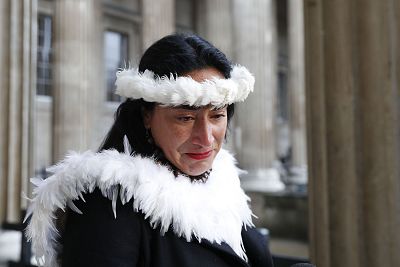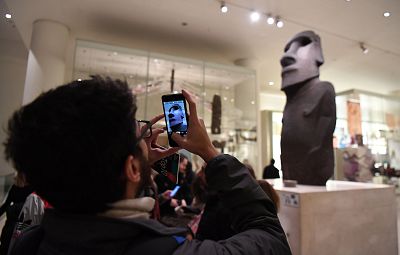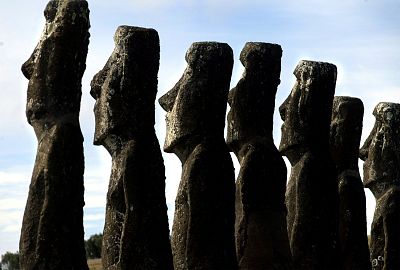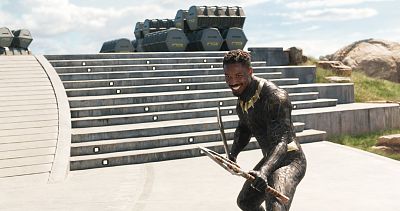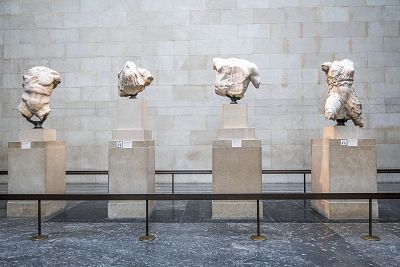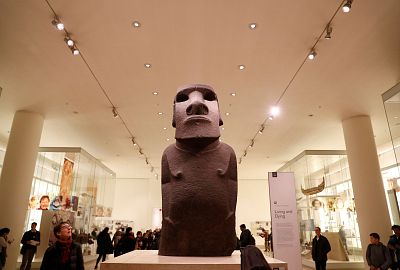"We are just a body. You, the British people, have our soul ... You have kept him for 150 years. Just give us some months."
LONDON — As swarms of tourists jostle for position beneath this towering statue, its hollow eyes reveal little about its painful past.The 7-foot-9-inch basalt figure was carved perhaps 800 years ago on Easter Island, one of the most remote places on earth.In 1868, it was plundered by a British naval ship, sailed 11,000 miles around the world and handed to Queen Victoria.The monarch gave it to London's British Museum, where it still stands 150 years later, scowling in the background of a thousand selfies.Tourists love it, but the Rapa Nui people of Easter Island are begging the museum to return the statue.Their ancestors named it Hoa Hakananai'a, or "stolen friend" according to one translation, and they believe it contains the spirits of their deified relatives."We came here, but we are just the body. You, the England people, have our soul," said Tarita Alarcón Rapu, the governor of Easter Island, during a visit to the British Museum this week.Speaking through tears on the museum's grand steps, she pleaded for even a brief loan of the sacred artifact."You have kept him for 150 years," she said. "Just give us some months and we can have it there."
Hoa Hakananai'a is one of 1,000 iconic "moai" statues carved on Easter Island, a UNESCO World Heritage Site that's now part of Chile.It's also one of countless controversial objects displayed in European museums that were taken or outright looted from abroad — in Britain's case as it expanded its empire in the 1800s.Many of the countries are now asking for the artifacts to be returned, a trend forcing the United Kingdom to face up to the most violent days of its colonial history."I had no idea about this statue's backstory," said one tourist, Avijit Dasgupta, 33, who was visiting London from Bangladesh last week.He had just been snapping photographs of Hoa Hakananai'a, which has been placed opposite the museum's gift shop. After learning of its turbulent past — not explained anywhere in the exhibit — he changed his mind.
"Now I know, I'm sure that this should be returned to the ancestors of the people who created it," he said.Another museumgoer, Margaret Robertson, 70, was aware of the controversy but had a different view."For me personally, which is a bit selfish, I like to experience their culture," she said. "We went on a cruise last year but we didn't make it to Easter Island. This statue means I can see it here instead."Britain is far from alone in this debate.France has tens of thousands of items taken from sub-Saharan Africa. A government-commissioned report is later this month expected to recommend they all be returned to countries that want them.In the U.S., Native American groups have for decades requested the return of items taken while tribes were being moved onto reservations at the turn of the last century.
Unlike in Europe, however, Congress passed two laws in 1989 and 1990 compelling museums and other collections to give back Native American items upon request.That's not to say the British Museum hasn't given back some items — but these have only been loans."The British Museum has, historically, been extremely reluctant to repatriate objects," said Alice A. Procter, a historian who gives "Uncomfortable Art Tours" revealing the controversial backgrounds of displayed items. "They make life very, very difficult for anyone claiming cultural heritage."This tension was directly addressed in the film "Black Panther," when Erik Killmonger, played by Michael B. Jordan, steals a war-hammer on display at the "The Museum of Great Britain" — a thinly veiled reference to the British Museum. As he explains, it was stolen from the imagined African nation of Wakanda.
"How do you think your ancestors got these?" Killmonger asks the museum director. "Do you think they paid a fair price? Or did they take it like they took everything else?"The Wakandan war-hammer echos the story of the real-life Benin Bronzes. In 1897, when European powers were busy carving up Africa, British forces attacked, burned and looted Benin City, an ancient and relatively advanced citadel in modern-day Nigeria.The "massacre of Benin" brought to an end the Kingdom of Benin, and the British troops returned with a series of ornate bronze plaques that, like Hoa Hakananai'a, are on display at the British Museum today.The museum has discussed a possible loan with the Nigerian government — but a permanent return has never been on the table.More infamous still are the Elgin Marbles, statues that once decorated the Parthenon temple in ancient Athens 2,500 years ago.
In the early 1800s, Lord Elgin gained permission from the Ottoman Empire, where he served as British ambassador, to remove the marble statues, around half of which had been damaged by neglect and war.The Greeks disagree. They see the Ottomans of the time as occupiers and have for decades lobbied the U.K. for the artifacts' return.So how does the British Museum justify hanging onto these items?Spokeswoman Hannah Boulton accepts that, at its heart, this argument is about weighing up two things: the museum's mission statement to educate the public and preserve ancient history, and those cultures' right to have their artifacts back."We believe that there is great value in presenting objects from across the world," Boulton said, adding that Hoa Hakananai'a is "among the most popular and most photographed exhibits with our 6 million visitors each year."
Others point to what can happen when items are left in less secure locations. In 2015, ISIS used bulldozers, power tools and explosives to damage and destroy several archaeological sites, including parts of the ancient city of Palmyra. UNESCO called it "an immense loss for the Syrian people and for humanity."This week, the British Museum "had a warm, friendly and open conversation" with the Rapa Nui delegation and said "it was very helpful to gain a better understanding of Hoa Hakananai'a's significance," Boulton said. But there has been no offer of its return, on loan or otherwise.Activists say that the reason this debate has become so difficult to navigate is that Britain has not faced up to the evils committed during its age of empire.More than 40 percent of Brits say they are proud of their country's history of colonialism, according to a survey in 2016 by the U.K. pollster YouGov.
This may owe more to ignorance more than malice. Critics say British schools fails to teach the true impact their country had during that period. The history Britain teaches itself is one of victorious campaigns in World War I and II, rather than the earlier atrocities committed in the name of the empire."The museum conversation is only the first part of a much, much bigger debate in reconsidering the way that colonial history is represented and discussed in the U.K.," said Procter, the historian."Museums are very much at the forefront of that because of the repatriation debate, and as part of that, they have a duty to engage and adapt their policies to suit the time," she added.












